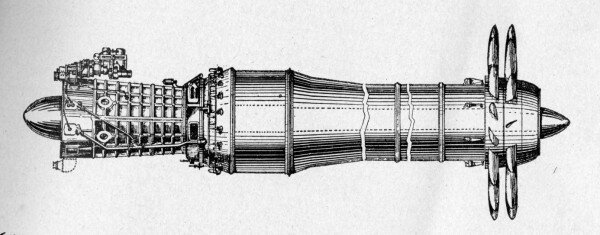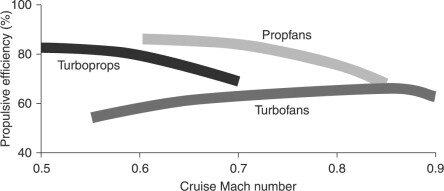What has been done with the aerodynamics of fan housings-nacelles? No golf dimples or other tricks beyond keeping things smooth?
The main changes have been consequences of increasing bypass ratios, from pure turbojet to high-bypass and eventually open-rotor fans.
First, the matter of length. In a pure jet, the front section is a compressor not a fan. Its high-pressure outflow really helps the efficiency of the combustion-turbine cycle. At low speeds it must draw air in, while at supersonic speeds it has to slow the air down. The pressure difference across the blades provides significant thrust.
The next development was the bypass turbofan, in which the outer part of the front blades does act as a fan to accelerate the air backwards and push air past the core jet. The fan action still provides thrust but, like a propeller, from acceleration rather than compression. This air is then typically mixed with the jet exhaust to increase the net mass flow of the exhaust at the expense of exhaust velocity, which further improves overall efficiency. This led to the widespread use of two- and eventually three-spool turbofans, with the outer spool essentially carrying a fan and the inner a compressor.
The high-bypass turbofan pushes back even more air, too much to mix with the exhaust. In this respect it acts somewhat as a cross between a turboprop and a turbojet, gaining much of the efficiency (and hence economy) of the turboprop; something like 70% of the thrust is now provided by the fan - the core jet still provides the other 30% or so. There is no longer any need to run the fan duct all the way back to the exhaust, and so the cowling got cut short part way along.
Internally, every surface needs to be as aerodynamically smooth and precise as possible. No boundary-layer gimmicks, other than a splitter plate to divert the boundary layer of a forward fuselage or similar away from the engine. However noise reduction has also become important, not only through environmental concerns but also because designers have learned to drive their fan tips at supersonic speeds. Key sections of the casing may be riddled with small holes to allow the acoustic pressure waves a way out into sound-absorbing stuffing; to tailor the acoustic bandwidth the holes must relate precisely to the gaps in the stuffing, yet must be kept small enough not to affect the boundary layer. The fan blades also need to fit as closely as possible to avoid aerodynamic losses, with minimal gap between them and the cowling. Rubbing strips were developed, so that the blades can be made fractionally oversize and wear down to the best fit possible.
The cowling inner fore-aft profile is critical in ensuring the correct flow of air, especially whether it is to be compressed and perhaps slowed for burning, or accelerated for direct thrust. It is also strongly affected by the outer profile of the shaft, which has a lot of jobs like strength, stiffness, lubrication and instrumentation to cover. The cross sectional area of the air duct is in turn directly related to the air speed, pressure and temperature. Together the shaft and air duct dictate the cowling profile. As technology advances, these parameters change and the cowling profiles evolve.
The cowling outer fore-aft profile can be varied locally. If the mounting pylon is short, the airflow between the wing and cowling becomes the design feature that the cowling must fit to. If the undercarriage legs are a bit short, then the bottom of the cowling may get flattened off a bit to keep it off the ground.
Of course, if the fan is open then the opportunity for various of these tricks is lost. You will have to accept higher tip losses and an airflow stream-tube profile that makes itself up as it goes along. You will also need to profile the blade tips for low noise because there is no absorbent wrapper any more, and abandon all thoughts of supersonic blade tips and maximised high-subsonic cruise speed. On the other hand removing the cowling reduces weight, while allowing longer blades and hence increased mass flow. These offer efficiency gains to compensate.
But how and why does this still differ from an advanced turboprop? What technical distinction makes the Europrop TP400 a turboprop and the Progress D.27 a propfan? That is what this thread is supposed to be about, but it is the one thing nobody here has been able to address.


